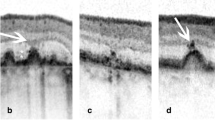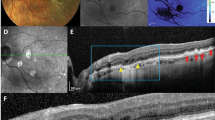Abstract
Background
To analyze the integrated confocal scanning laser ophthalmoscopy (cSLO) fundus and angiographic imaging and corresponding spectral domain optical coherence tomography (SD-OCT) features of cuticular drusen.
Methods
Twenty-one consecutive patients with cuticular drusen were submitted to cSLO fundus and angiographic imaging [infrared reflectance (IR), fundus autofluorescence (FAF), near-infrared autofluorescence (NIA), fluorescein angiography (FA), and indocyanine green angiography (ICGA)) and “eye-tracked” SD-OCT.
Results
A total of 42 eyes were included for analysis. BCVA ranged from 20/20 to 20/400. In 5/42 eyes, cSLO imaging and corresponding SD-OCT showed coincident vitelliform macular detachment, and in 9/42 eyes showed coincident geographic atrophy (GA). The “typical” cuticular drusen, intensely staining on early FA phase (“stars-in-the-sky” appearance in the fundus), appeared as “sawtooth” retinal pigment epithelium (RPE) elevation on SD-OCT. Some “atypical” cuticular drusen appeared, on early FA and ICGA frames, as hyper-fluoresecent lesions surrounded by faint hypo-fluoresecent halos. These lesions, which became intensely hyper-fluorescent in the late FA and ICGA phases, appeared, on SD-OCT, as small, confluent “dome-shaped” RPE elevations. Interestingly, some less intensely staining cuticular drusen (FA and ICGA) appeared as irregular slight thickening of RPE/Bruch's membrane complex on SD-OCT scans.
Conclusion
Integrated imaging makes it possible to highlight different features within cuticular drusen-containing regions, and gives insights into pathology. We suggest that “typical” cuticular drusen may represent a continuous layer of early basal laminar deposit (BLamD) associated with membranous debris accumulation. As early BLamD thicken, the lesions become richer in solid lipid particles, and “atypical” cuticular drusen may develop.




Similar content being viewed by others
References
Zarbin MA (2004) Current concepts in the pathogenesis of age-related macular degeneration. Arch Ophthalmol 122:598–614
Pauleikhoff D, Barondes MJ, Minassian D, Chisholm IH, Bird AC (1990) Drusen as risk factors in age-related macular disease. Am J Ophthalmol 109:38–43
Gass JD (1977) Stereoscopic atlas of macular diseases. CV Mosby, St Louis
Leys A, Vanrenterghem Y, Van Damme B, Snyers B, Pirson Y, Leys M (1991) Fundus changes in membranoproliferative glomerulonephritis type II. A fluorescein angiographic study of 23 patients. Graefes Arch Clin Exp Ophthalmol 229:406–410
Gass JDM, Jallow S, Davis B (1985) Adult vitelliform macular detachment occurring in patients with basal laminar drusen. Am J Ophthalmol 99:445–59
Russell SR, Mullins RF, Schneider BL, Hageman GS (2000) Location, substructure, and composition of basal laminar drusen compared with drusen associated with aging and age-related macular degeneration. Am J Ophthalmol 129:205–214
Leng T, Rosenfeld PJ, Gregori G, Puliafito CA, Punjabi OS (2009) Spectral domain optical coherence tomography characteristics of cuticular drusen. Retina 29:988–993
Sarks S, Cherepanoff S, Killingsworth M, Sarks J (2007) Relationship of Basal laminar deposit and membranous debris to the clinical presentation of early age-related macular degeneration. Invest Ophthalmol Vis Sci 48:968–977
Curcio CA, Presley JB, Millican CL, Medeiros NE (2005) Basal deposits and drusen in eyes with age-related maculopathy: evidence for solid lipid particles. Exp Eye Res 80:761–775
Li CM, Chung BH, Presley JB, Malek G, Zhang X, Dashti N, Li L, Chen J, Bradley K, Kruth HS, Curcio CA (2005) Lipoprotein-like particles and cholesteryl esters in human Bruch’s membrane: initial characterization. Invest Ophthalmol Vis Sci 46:2576–2586
Li CM, Clark ME, Chimento MF, Curcio CA (2006) Apolipoprotein localization in isolated drusen and retinal apolipoprotein gene expression. Invest Ophthalmol Vis Sci 47:3119–3128
Starita C, Hussain AA, Pagliarini S, Marshall J (1996) Hydrodynamics of ageing Bruch’s membrane: implications for macular disease. Exp Eye Res 62:565–572
Moore DJ, Clover GM (2001) The effect of age on the macromolecular permeability of human Bruch’s membrane. Invest Ophthalmol Vis Sci 42:2970–2975
Hussain AA, Rowe L, Marshall J (2002) Age-related alterations in the diffusional transport of amino acids across the human Bruch’schoroid complex. J Opt Soc Am A Opt Image Sci Vis 19:166–172
Hillenkamp J, Hussain AA, Jackson TL, Cunningham JR, Marshall J (2004) The influence of path length and matrix components on ageing characteristics of transport between the choroid and the outer retina. Invest Ophthalmol Vis Sci 45:1493–1498
Sarks SH, Sarks JP (2001) Age-related maculopathy: non-neovascular age-related macular degeneration and the evolution of geographic atrophy. In: Ryan S (ed) Medical Retina, 3rd edn. Mosby, St. Louis, pp 1064–1099
Acknowledgement
This study was presented in part at the XXVIIth Meeting of the Club Jules Gonin.
Financial or material support for the research and the work
none.
Conflict of interest
The authors have no proprietary interest in the materials used in this study.
Author information
Authors and Affiliations
Corresponding author
Rights and permissions
About this article
Cite this article
Querques, G., Guigui, B., Leveziel, N. et al. Insights into pathology of cuticular drusen from integrated confocal scanning laser ophthalmoscopy imaging and corresponding spectral domain optical coherence tomography. Graefes Arch Clin Exp Ophthalmol 249, 1617–1625 (2011). https://doi.org/10.1007/s00417-011-1702-0
Received:
Revised:
Accepted:
Published:
Issue Date:
DOI: https://doi.org/10.1007/s00417-011-1702-0




